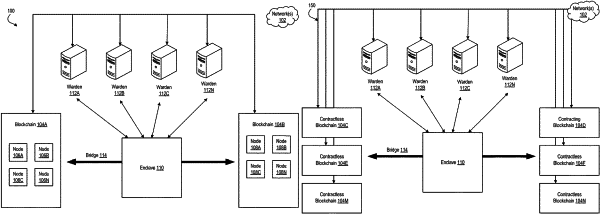| CPC G06Q 20/3676 (2013.01) [G06Q 20/3674 (2013.01); G06Q 20/3825 (2013.01); G06Q 20/3829 (2013.01)] | 12 Claims |

|
1. A system for secure transfer of assets between blockchain networks, the system comprising:
a secure-execution server comprising one or more processors and memory, the memory storing a bridge program, wherein the one or more processors and the memory provide a secure execution environment that, when the bridge program is executed by the one or more processors in the secure execution environment, is configured to interact with a first pool of warden servers to facilitate secure transfer of assets between a first blockchain network that comprises a contractless blockchain network and a second blockchain network that comprises a contracting blockchain network, the bridge program comprising instructions stored in the memory that, when executed by the secure execution environment, cause the secure-execution server to perform operations comprising:
performing lock operations that lock first assets in the contractless blockchain network and mint second assets representing the first assets in the contracting blockchain network, wherein:
a single mnemonic address is used with: i) a first non-custodial wallet supported by the contractless blockchain to deterministically generate a plurality of corresponding keys for addresses on the contractless blockchain network that correspond to the single mnemonic address, and ii) a second non-custodial wallet supported by the contractless blockchain to deterministically generate a single corresponding key for addresses on the contracting blockchain network that also correspond to the single mnemonic address; and
locking the first assets comprises receiving the first assets from one or more addresses on the contractless blockchain network that correspond to the single mnemonic address and minting the second assets comprises transferring the second assets to one or more addresses on the contracting blockchain network that also correspond to the single mnemonic address; and
performing unlock operations, after performing the lock operations and in response to confirming the second assets have been returned or destroyed on the contracting blockchain network, that unlock the first assets on the contractless blockchain network, wherein performing the unlock operations comprises:
determining an expected transfer-fee for the unlock operation based on (i) a value of the first assets, (ii) a value of unspent transaction output (UTXO) objects available to the bridge program, and (iii) a bridge fee of the bridge program;
providing the determined expected transfer-fee for presentation by a graphical user interface (GUI);
receiving an indication of approval for the unlock operations that has been provided through the GUI;
in response to receiving the indication of approval for the unlock operations, (i) deducting the expected transfer-fee from the first assets, (ii) incurring an actual transfer-fee for the unlock operations, wherein the actual transfer-fee is different from the expected transfer-fee, and (iii) adjusting a balance of an overflow account according to a difference between the expected transfer-fee and the actual transfer-fee; and
transferring the first assets from the first non-custodial wallet to another wallet supported on the contractless blockchain network.
|